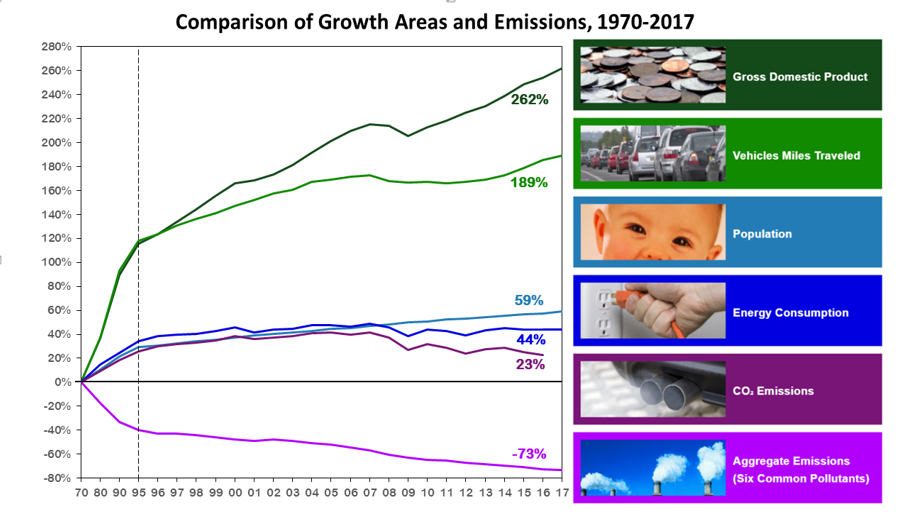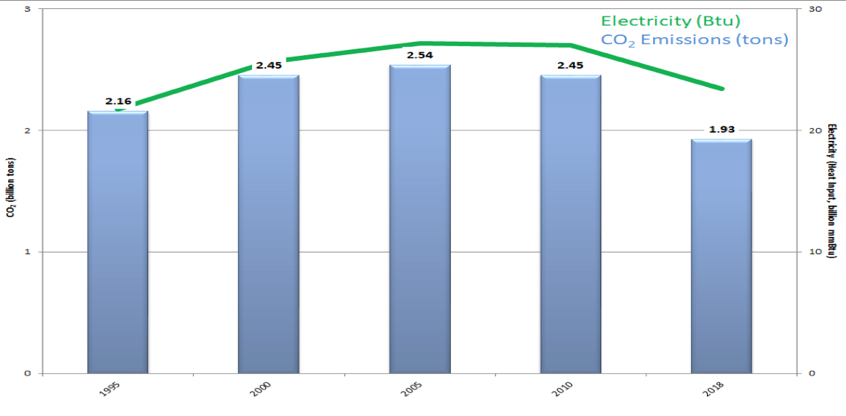According to its founder, Gaylord Nelson, Earth Day was founded in 1970 to create “an environment of decency, quality, and mutual respect for all human creatures and all living things.” In many ways, the United States is a model of those qualities, but, as always, more can be done. As we continue our goal of improving the economic well-being of Americans, we will also improve our environment at the same time. Abundant, affordable and reliable energy that the United States currently enjoys speeds economic progress and therefore also speeds the realization of a cleaner environment.
U.S. Strides in Air Quality
A good example of economic and environmental improvements is America’s air quality success. Despite claims of gloom and doom, air quality in the United States continues to improve, even as our economy, automobile use, population, and energy consumption increase. This is a rarely told success story as environmentalists push what they believe to be the dangers of climate change. The graph below from the Environmental Protection Agency demonstrates the success of our clean air efforts in reducing criteria pollutants that cause acid rain. Between 1970 and 2017, U.S. gross domestic product increased 262 percent, vehicle miles traveled increased 189 percent, energy consumption increased 59 percent, and U.S. population increased by 44 percent. During the same time period, total emissions of the six principal air pollutants dropped by 73 percent.

It was not Earth Day, the creation of the Environmental Protection Agency, or the passage of the Clean Air Act, however, that is responsible for these air quality improvements. Air quality improved for decades even before Congress passed the Clean Air Act Amendments of 1970.
The reason our air quality improved is quite simple: when people become wealthier, they can more easily afford cleaner water and air. When the industrial revolution started in America, environmental quality first decreased. However, as wealth increased, environmental quality quickly improved, even beyond previous levels. As the graph above shows, greater wealth leading to greater environmental quality has continued over time.
Research on environmental quality and wealth implies that we will overcome environmental challenges only if we increase our wealth and technology. Government programs were not responsible for the great strides we have made to our environment. For example, the discovery and use of oil helped end the slaughter of whales for whale oil. A century ago, our streets were littered with horse manure. Today our streets are manure-free not because of improved street cleaners, but because people stopped using horses and started using electric-powered street cars, diesel powered buses, and gasoline powered automobiles.
The reason we switched our major energy sources from biomass-fueled horses and whales is because we developed alternatives that made economic sense. Sadly, governments fail to understand that key fact—people will switch to alternative energy sources precisely when it makes economic sense to do so.
Carbon Dioxide Emissions
Despite the above graph showing that carbon dioxide emissions increased by 23 percent between 1970 and 2016, the real story is in our more recent achievements in reducing those emissions in the generating sector. U.S. carbon dioxide emissions in the power sector declined by 24 percent between 2005 and 2018 due to lower coal-fired generation and increasing generation primarily from natural gas, which emits less carbon dioxide than coal, and, to a lesser extent, increasing renewable generation as a result of states’ renewable energy mandates and Federal and state subsidies totaling billions of dollars each year.
Carbon dioxide emissions from the U.S. generating sector declined from 2.54 million tons in 2005 to 1.93 million tons in 2018, as the graph below shows. Unlike the criteria pollutants shown in the above graph where cost-effective technology was able to lower emissions, there is no inexpensive way to remove carbon dioxide emissions when combusting fossil fuels to generate electricity. Current carbon scrubber technology is expensive and not proven on a commercial scale.
Carbon Dioxide Emissions, 1995-2018

Government Intervention
Instead of relying on Americans to make the best choices about which energy sources make the most sense, the federal government has been trying for years to make politically-correct energy sources like wind and solar cost-effective. Despite billions of dollars in subsidies and state mandates forcing electric utilities to buy solar and wind power, wind and solar energy combined produced only 3.4 percent of our energy needs in 2018, while coal, natural gas, and oil continued to contribute 80 percent. That 80 percent contribution resulted despite some state banning hydraulic fracturing technology that spurred our oil and gas renaissance and some states denying permits for oil and gas pipeline construction.
Wind and solar energy reached a higher market share in the generating sector, producing 8.2 percent of our electricity in 2018. However, forcing wind and solar energy into the generating sector had its consequences as electricity prices increased by 8.6 percent between 2008 and 2018, while electricity demand increased only by 1.4 percent. In other words, the United States did not need to build new generating capacity—we had enough to meet demand. In fact, we even had excess.
Many might want to blame coal and natural gas for the electricity price increases, but during this time, natural gas prices decreased by 61 percent and coal prices remained flat.
Because the federal production tax credit for wind is provided for the next ten years of a wind unit’s operation, federal subsidies to wind will continue for years. The U.S. Treasury estimates that the production tax credit will cost U.S. taxpayers $40.12 billion from 2018 to 2027, making it the most expensive energy subsidy under current tax law despite its current expected phase out.
What also forced the building of wind and solar units were mandates from the states for their future generation. The states that saw some of the largest electricity price increases were states that mandated the use of renewable electricity. For example, the states of South Dakota, North Dakota, Oklahoma, Kansas, Texas, and Iowa receive about 30 percent or more of their generation from wind and solar power today than they did in 2009, but that increase was accompanied by an increase in their electricity prices, as follows:
- In North Dakota, electricity prices increased 32 percent while electricity from solar and wind grew from nine to 27 percent between 2009 and 2017.
- In South Dakota, electricity prices increased 36 percent while electricity from solar and wind grew from five to 30 percent between 2009 and 2017.
- In Kansas, electricity prices increased 33 percent while electricity from solar and wind grew from six to 36 percent between 2009 and 2017.
- In Iowa, electricity prices increased 18 percent while electricity from solar and wind grew from 14 to 37 percent between 2009 and 2017.
- In Oklahoma, electricity prices increased 18 percent while electricity from solar and wind grew from four to 32 percent between 2009 and 2017.
Conclusion
As we take the time to reflect on the message of the original Earth Day, we should remember what has been proven to work in the past—wealth creates the conditions that lead to environmental improvements. Politicians should not be in the business of telling us which energy sources we can or cannot use. History shows that people who are free to use what energy sources make the most economic sense also find the best choice for the environment.



